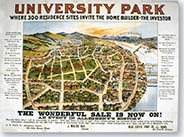American Issues  Connector: Migration and Urbanization
Connector: Migration and Urbanization

A modern suburb of Las Vegas, Nevada
TRACK THE ISSUE
![]() How does migration affect patterns of settlement in America?
How does migration affect patterns of settlement in America?
Several migration trends have shaped settlement patterns in the United States. One is the movement of people to the West and to the southern “Sunbelt.” Another is the movement from rural to urban areas, which then developed suburbs. These migrations have had a great influence on American life. Use the timeline below to explore this enduring issue.
-
1862 Homestead Act
Offer of free land brings settlers to the Great Plains.
-
1880–1920 Urban Migration
Millions of Americans leave farms for the city. By 1920, urban population exceeds rural population.
-
1910–1930 Great Migration
Southern blacks move north, giving rise to African American neighborhoods.
-
1950s Suburban Flight
Mass movement from central cities to suburbs begins.
-
1970s–Present Sunbelt Growth
Sunbelt states grow rapidly as Americans move to the warmer, southern half of the country.

A poster advertising a “streetcar suburb” of the late nineteenth century
DEBATE THE ISSUE
Expanding Suburbs American suburbs began in the 1800s but mushroomed after World War II. By 1990, nearly half of all Americans lived in suburbs. These communities offered many benefits. But critics say they have contributed to urban sprawl, traffic congestion, and other problems.
“Suburbanization represents a significant improvement in the quality of life for people who settle there. Most people who move out of their older homes do so because their needs have changed. Suburban and rural areas often meet these new needs better than older, more densely populated central cities.”
—Samuel Staley, Reason Public Policy Institute
“Sprawling patterns of growth are an inefficient use of land that scatters jobs, houses, schools and shopping across the landscape…. It leaves people little choice but to use their auto for any trip…. It fragments the ecosystems that protect our drinking water and wildlife habitat and that provide recreational opportunities that we all enjoy.”
—Robert J. Pirani, Regional Plan Association, New York
 TRANSFER Activities
TRANSFER Activities
- Compare How do the two quotations differ in their perspective on suburbs?
- Analyze How did the growth of the suburbs affect urban life and growth?
- Transfer Use the following Web site to see a video, try a WebQuest, and write in your journal. Web Code: neh-7402




